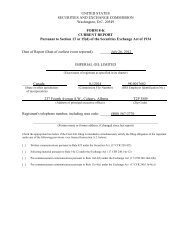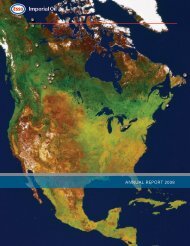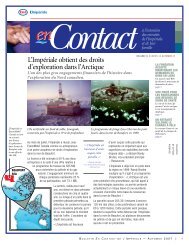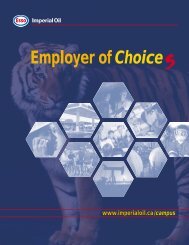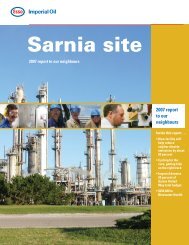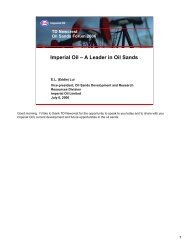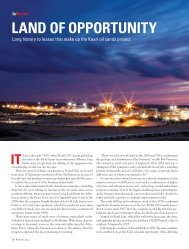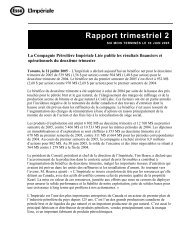FORM 10-K IMPERIAL OIL LIMITED
FORM 10-K IMPERIAL OIL LIMITED
FORM 10-K IMPERIAL OIL LIMITED
You also want an ePaper? Increase the reach of your titles
YUMPU automatically turns print PDFs into web optimized ePapers that Google loves.
Notes to consolidated financial statements<br />
1. Summary of significant accounting policies<br />
The company’s principal business is energy, involving the exploration, production, transportation and sale of crude oil and natural gas and t h e<br />
m a n u f a c t u re, transportation and sale of petroleum products. Imperial is also a major manufacturer and marketer of petro c h e m i c a l s .<br />
The consolidated financial statements have been prepared in accordance with generally accepted accounting principles (GAAP) in the United States of<br />
America. The financial statements include certain estimates that reflect management’s best judgment. All amounts are in Canadian dollars unless<br />
otherwise indicated.<br />
Principles of consolidation<br />
The consolidated financial statements include the accounts of Imperial Oil Limited and its subsidiaries. Intercompany accounts and transactions are<br />
eliminated. Subsidiaries include those companies in which Imperial has both an equity interest and the continuing ability to unilaterally determine strategic<br />
operating, investing and financing policies. Significant subsidiaries included in the consolidated financial statements include Imperial Oil Resourc e s<br />
Limited, Imperial Oil Resources N.W. T. Limited, Imperial Oil Resources Ve n t u res Limited and McColl-Frontenac Petroleum Inc. All of the above companies<br />
a re wholly owned. A significant portion of the company’s activities in natural re s o u rces is conducted jointly with other companies. The accounts reflect the<br />
c o m p a n y ’s share of undivided interest in such activities, including its 25-percent interest in the Syncrude joint venture and its nine-percent interest in the Sable<br />
o ff s h o re energ y p roject.<br />
Segment reporting<br />
The company operates its business in Canada in the following segments:<br />
Natural resources includes the exploration for and production of crude oil and natural gas.<br />
Petroleum products comprises the refining of crude oil into petroleum products and the distribution and marketing of these products.<br />
Chemicals includes the manufacturing and marketing of various hydrocarbon-based chemicals and chemical products.<br />
The above functions have been defined as the operating segments of the company because they are the segments (a) that engage in business activities<br />
from which revenues are earned and expenses are incurred; (b) whose operating results are regularly reviewed by the company’s chief operating decisionmaker<br />
to make decisions about resources to be allocated to the segment and assess its performance; and (c) for which discrete financial information is<br />
available.<br />
Corporate and other includes assets and liabilities that do not specifically relate to business segments – primarily cash and long-term debt. Net income<br />
in this segment primarily includes financing costs and interest income.<br />
Segment accounting policies are the same as those described in this summary of significant accounting policies. Natural resources, petroleum products<br />
and chemicals expenses include amounts allocated from the ”corporate and other” segment. The allocation is based on a combination of fee for service,<br />
proportional segment expenses and a three-year average of capital expenditures. Transfers of assets between segments are recorded at book amounts.<br />
Items included in capital employed that are not identifiable by segment are allocated according to their nature.<br />
Inventories<br />
Inventories are recorded at the lower of cost or net realizable value. The cost of crude oil and products is determined primarily using the last-in, first-out<br />
(LIFO) method. LIFO was selected over the alternative first-in, first-out and average cost methods because it provides a better matching of current costs<br />
with the revenues generated in the period.<br />
Inventory costs include expenditures and other charges, including depreciation, directly or indirectly incurred in bringing the inventory to its existing<br />
condition and final storage prior to delivery to a customer. Selling and general expenses are reported as period costs and excluded from inventory costs.<br />
Investments<br />
The principal investments in companies other than subsidiaries are accounted for using the equity method. They are recorded at the original cost of the<br />
investment plus Imperial’s share of earnings since the investment was made, less dividends received. Imperial’s share of the after-tax earnings of these<br />
companies is included in ”investment and other income” in the consolidated statement of income. Other investments are recorded at cost. Dividends from<br />
these other investments are included in ”investment and other income.”<br />
These investments represent interests in non-publicly traded pipeline companies that facilitate the sale and purchase of crude oil and natural gas in the<br />
conduct of company operations. Other parties who also have an equity interest in these companies share in the risks and rewards according to their<br />
percentage of ownership. Imperial does not invest in these companies in order to remove liabilities from its balance sheet.<br />
Property, plant and equipment<br />
Property, plant and equipment is recorded at cost. Investment tax credits and other similar grants are treated as a reduction of the capitalized cost of the<br />
asset to which they apply.<br />
The company uses the successful-efforts method to account for its exploration and production activities. Under this method, costs are accumulated on a<br />
field-by-field basis with certain exploratory expenditures and exploratory dry holes being expensed as incurred. The company continues to car ry as an<br />
asset the cost of drilling exploratory wells that find sufficient quantities of reserves to justify their completion as producing wells if the required capital<br />
expenditure is made and drilling of additional exploratory wells is underway or firmly planned for the near future. Once exploration activities demonstrate<br />
that sufficient quantities of commercially producible reserves have been discovered, continued capitalization is dependent on project reviews, which take<br />
place at least annually, to ensure that satisfactory progress toward ultimate development of the reserves is being achieved. Exploratory well costs not<br />
meeting these criteria are charged to expense. Costs of productive wells and development dry holes are capitalized and amortized on the unit-ofproduction<br />
method for each field. The company uses this accounting policy instead of the full-cost method because it provides a more timely accounting<br />
of the success or failure of the company’s exploration and production activities.<br />
F-7



